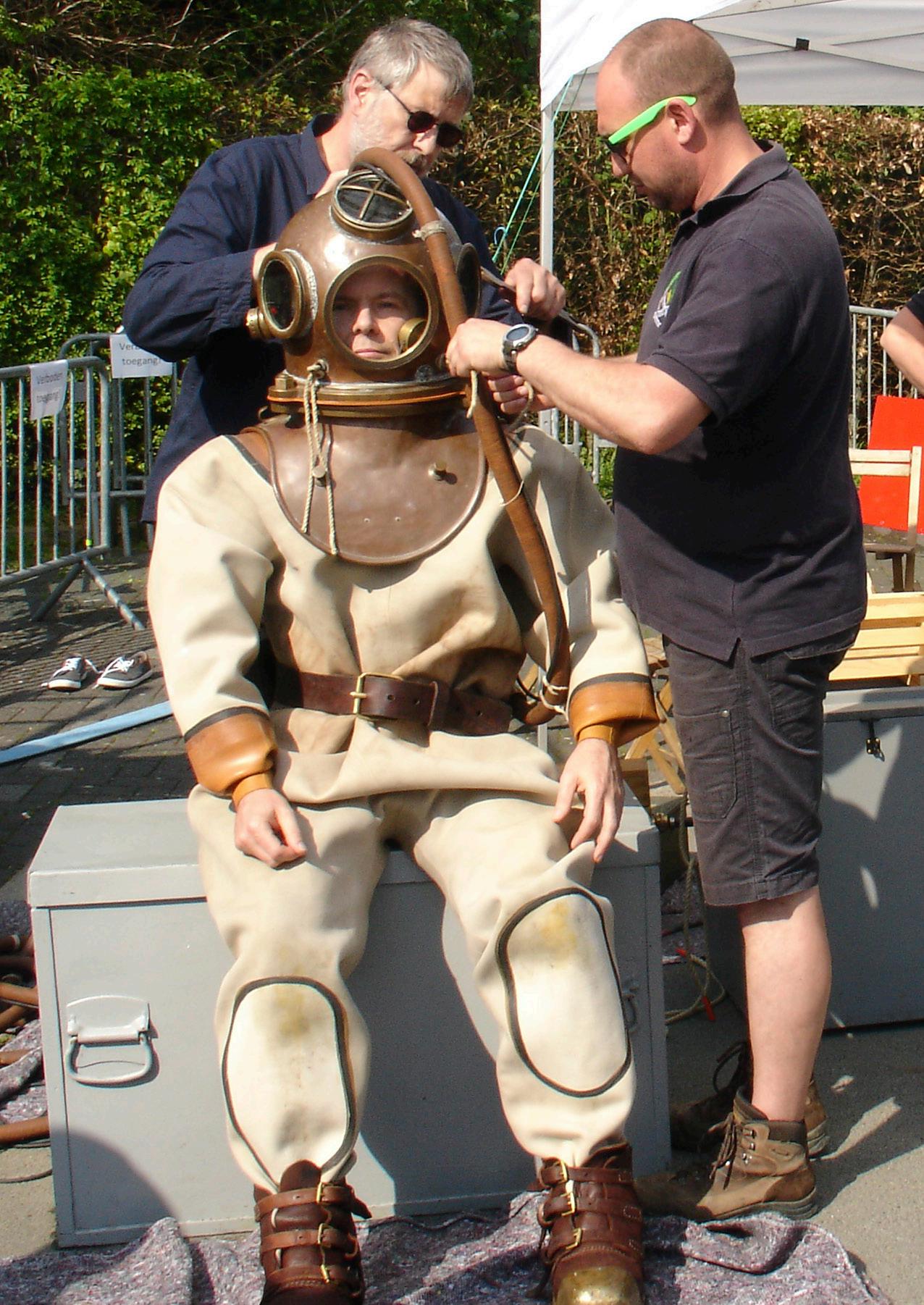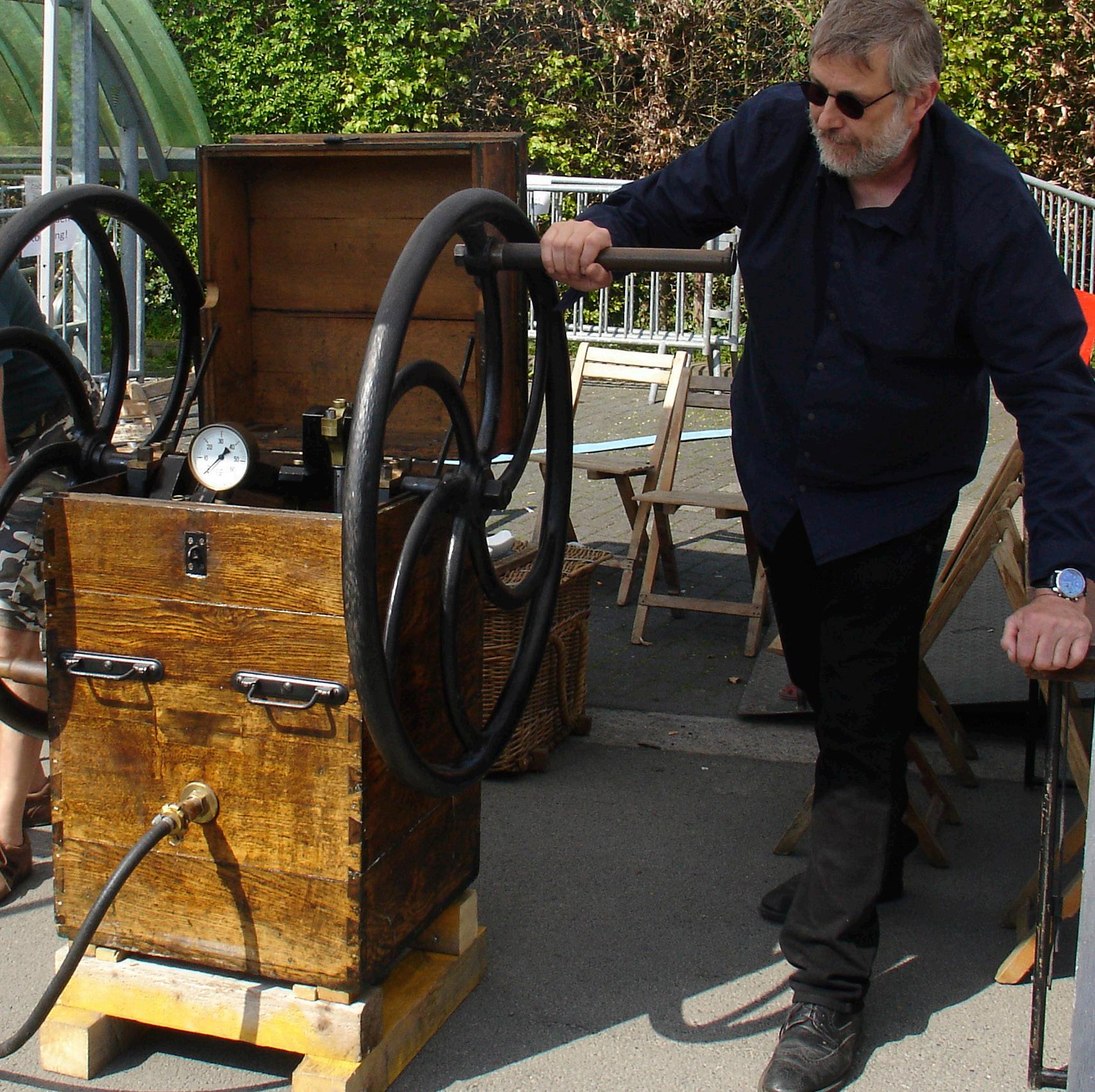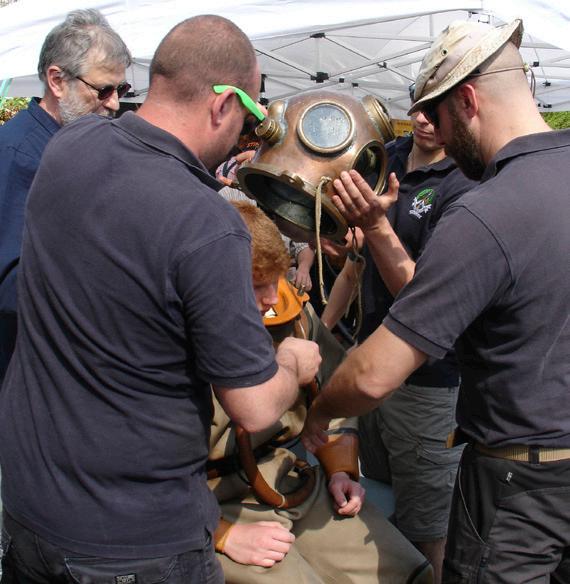
7 minute read
My Buddies The Helmet Divers
FEATURE PATRICK VAN HOESERLANDE

I have already broadly interpreted the concept of ‘buddy’ in this series of articles, certainly much more loosely than I had anticipated at the start. For this article, I want to go beyond the original, rather limiting definition, written in almost every sports diving manual of a buddy as a fellow diver, without however, forcing the spirit of the word. The title has already given it away for my next ‘buddy’ dive, with a complete team of ‘buddies’. After all, you can’t do this kind of diving alone, not even with two, but rather with a group.
On a wonderful summers day in April, I drove to Lebbeke, Belgium for a dive in what ‘The Patrouilleurs’ call, the ‘beaker’. It would not be a standard dive and having heard the name, I guessed that it would be in a mobile water tank with window displays. Still, I was looking forward to this experience. I have dived with quite a few helmets, but this group focuses on equipment used during World War I, so I expected to see authentic ‘scaphandre’ equipment.
After I had parked my car, I headed off to the square where the dive was to take place. There was a large group of people standing around a container. Something was clearly going on. I saw water spill from the top of the container, and someone was standing on the top holding a big tube pipe in his hands. A sure sign of an active dive tank. I looked around and got my camera out to take some ambiant pictures, and headed to the nearby tent.
While introducing myself to a group member, I noticed two men operating a pump. It was a manual air pump that looked like it could have been 100 years old. It looked as if I had landed in a scene from the beginning of the last century. There was suddenly a commotion at the top of the tank. I heard a staircase screech and then a helmet diver appeared. He slowly came down the stairs where he was then freed of his heavy equipment.

The leader, David Moortgat, introduced me to his team and I was given an overview of the work of Belgian divers in ‘Bachten de Kupe’ (the nickname of the non-occupied area between the river ‘IJzer’ and the North Sea) during the First World War. I learned that keeping the lock complex of Nieuwpoort open, was the work of military helmet divers who sometimes had to carry out their activities under artillery fire. The work was necessary to preserve the protective water in front of our troops in the trenches and thus to defend the last piece of free Belgian territory. A historical fact in the history of diving that I had not known about.
It had come to my turn to get in the water, an attractive proposal in the warm weather. The first task was to get into the suit, a challenging undertaking. There is only one opening, and that is through the thick rubber neck seal. Two men stretched the ring slightly, while I, with great difficulty, wrestled myself through the hole. Once you’re through, things then go a lot faster. The many hands of a well-oiled team gear me up. With every second, I become heavier. When the diving helmet is placed on the copper ring, I suddenly find myself in my own ‘beaker’. The only contact with the outside world was through the thick glass of my helmet’s circular window, and the gravity forcibly pulled the lead attached to my body down towards the ground. David gave me instructions on how to equalise my ears and how to let the air out of the brass helmet. After confirming that the communication equipment worked, he gave me the signal to walk to the tank.
Every step required tremendous effort and at the top of the stairs, extra weight awaited me. Sweat was breaking out and I longed to get in that refreshing water. After a short pause, I was allowed to descend. With every step I took, I felt the force of gravity decrease and Archimedes took over. It was wonderful. Descending must happen ever so slowly because the pump crew must be able to follow the descent. In open water, a sudden and too rapid descent could result in the diver being forced, i.e. sucked, into the only incompressible volume, the helmet.
In the silence of the water, I could hear the reassuring sound of the pump at work. There were many spectators around the tank. I waved and posed for photos. It’s not every day that bystanders can take pictures of you diving underwater. David asked me if there were any leaks. I only noticed some drops of water most probably from condensation from the moist air pumped into the suit mixed with the cold interior of the helmet. I saw no reason for alarm. I walked along the bottom to appear at every display window. I heard David explaining things, but I couldn’t understand what he was saying and I wasn’t concerned. Those few cubic metres of water were now my kingdom.
Then I heard the click of the loudspeaker and David asked me to lie on the ground and let the air out of my suit. While I slowly moved into a reclining position, I pushed the back of my head against the outlet valve. I heard air escaping and the water pressure started to entangle my body. Fortunately, I didn’t feel any pushing force towards the helmet. I had barely lay down on the bottom when I heard the frequency of the pump increase. The air pressure in my suit began to increase and I started to feel a lot lighter. Thanks to the extra volume and power of Archimedes, I could easily get back on my feet. When David saw that my suit had begun to ventilate, he gave the pump team a sign to reduce the pace. You are not supposed to rise all the way up to the surface.
I walked a few more laps in my tank and I was then given the signal to come back up and climb the ladder back out. With every step, the feeling of weightlessness diminished, and gravity got a tighter hold of me. Climbing the stairs required a lot of muscle strength and coordination. The heavy helmet was removed, and I got the opportunity to pose with the helmet just like a ‘real’ diver, completely sweaty. I was stripped of all the equipment in no time and the suit was all that was left. Now the so-called ‘rebirth’ process began. I had to crawl back out through the rubber seal again. I had to make myself as thin as possible, and three of the team stretched the ring as far as possible. Thanks to the group effort, I was stripped of everything within just a few minutes.

The experience requires a long haul of preparation to kit up, but it is a very unique endeavour. It also gives you a sense of the adventure it was and the physical fitness needed by the first helmet divers back in the day. Diving in open water with such a system in sight of the enemy must have required a very strong stamina, unlike my child’s play in the tank.
We talked a bit about the dive and the history of helmet diving. When the team got ready for their final demonstration of the day, I thanked David and his team for giving me such a unique opportunity. Thanks to this group, a big part of Belgian underwater history will be preserved.
Who will be my next dive buddy? What part of diving will he or she introduce me to? Could you be my next buddy? If you are interested in proposing an invitation to something new, send me an email me at patrick.vanhoeserlande@nelos.be.

Dive Club: The Patrouilleurs
First Year: 2016 Total Dive
Demonstrations: 10 Member
Certifications: Two firefighter divers, one combat diver, one 2* and one 4* NELOS divers.
Special Equipment: ‘Standard’ diving equipment – ‘Charles Petit’ (Paris, France) and an air pump ‘Grand Profondeur’ – René Piel (Paris, France).
Favourite Dive Site: De Nekker, Belgium.
Most Fun Dive: A demonstration at the Passchendaele Museum in Zonnebeke, Belgium (2017).
Demo Location Wish: In a port with clear water.
Most Spectacular Helmet Dive: first dive after the restoration of the equipment in ‘De Nekker’, Mechelen, Belgium.










